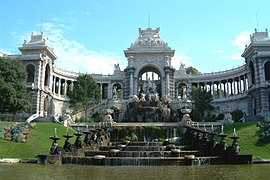Marseille
| Marseille | |||
|---|---|---|---|
| Prefecture and commune | |||
   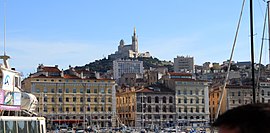   From top to bottom, left to right: Bompard, Le Panier, Calanques National Park, Old Port and Notre-Dame de la Garde, Palais Longchamp and Marseille Cathedral | |||
| |||
| Motto(s): Actibus immensis urbs fulget massiliensis "The city of Marseille shines from its great achievements" | |||
 Marseille Location within Provence-A.-C.d'A. region  Marseille | |||
| Coordinates: 43°17′47″N 5°22′12″E / 43.2964°N 5.37°E / 43.2964; 5.37Coordinates: 43°17′47″N 5°22′12″E / 43.2964°N 5.37°E / 43.2964; 5.37 | |||
| Country | France | ||
| Region | Provence-Alpes-Côte d'Azur | ||
| Department | Bouches-du-Rhône | ||
| Arrondissement | Marseille | ||
| Canton | 12 cantons | ||
| Intercommunality | Aix-Marseille-Provence | ||
| Government | |||
| • Mayor .mw-parser-output .noboldfont-weight:normal (since 1995) | Jean-Claude Gaudin (LR) | ||
| Area1 | 240.62 km2 (92.90 sq mi) | ||
| • Urban (2010) | 1,731.91 km2 (668.69 sq mi) | ||
| • Metro (2010) | 3,173.51 km2 (1,225.30 sq mi) | ||
| Population (Jan. 2016[1])2 | 869,815 | ||
| • Rank | 2nd after Paris | ||
| • Density | 3,600/km2 (9,400/sq mi) | ||
| • Urban (2014) | 1,578,484[2] | ||
| • Metro (Jan. 2011) | 1,831,500[3] | ||
| Demonym(s) | Marseillais (French) Marselhés (Occitan) Massiliot (ancient) | ||
| Time zone | UTC+1 (CET) | ||
| • Summer (DST) | UTC+2 (CEST) | ||
INSEE/Postal code | 13055 /13001-13016 | ||
| Dialling codes | 0491 or 0496 | ||
| Website | marseille.fr | ||
1 French Land Register data, which excludes lakes, ponds, glaciers > 1 km2 (0.386 sq mi or 247 acres) and river estuaries. 2Population without double counting: residents of multiple communes (e.g., students and military personnel) only counted once. | |||
Marseille (/mɑːrˈseɪ/; French: [maʁsɛj] (![]() listen), locally [mɑχˈsɛjə]; English alternative spelling: Marseilles; Provençal: Marselha [maʀˈsejɔ, -ˈsijɔ]) is the second-largest city of France. The main city of the historical province of Provence, today it is the capital of the department of Bouches-du-Rhône and region of Provence-Alpes-Côte d'Azur. It is located on France's south coast, covering an area of 241 km2 (93 sq mi) and had a population of 852,516 in 2012.[1] Its metropolitan area, which covers 3,173 km2 (1,225 sq mi) is the third-largest in France after Paris and Lyon, with a population of 1,831,500 as of 2010.[3]
listen), locally [mɑχˈsɛjə]; English alternative spelling: Marseilles; Provençal: Marselha [maʀˈsejɔ, -ˈsijɔ]) is the second-largest city of France. The main city of the historical province of Provence, today it is the capital of the department of Bouches-du-Rhône and region of Provence-Alpes-Côte d'Azur. It is located on France's south coast, covering an area of 241 km2 (93 sq mi) and had a population of 852,516 in 2012.[1] Its metropolitan area, which covers 3,173 km2 (1,225 sq mi) is the third-largest in France after Paris and Lyon, with a population of 1,831,500 as of 2010.[3]
Known to the ancient Greeks and Romans as Massalia[4] (Greek: Μασσαλία, Massalía),[5][6] Marseille was an important European trading centre and remains the main commercial port of the French Republic. Marseille is now France's largest city on the Mediterranean coast and the largest port for commerce, freight and cruise ships. The city was European Capital of Culture in 2013 and European Capital of Sport in 2017; it hosted matches at the 1998 World Cup and Euro 2016. It is home to Aix-Marseille University.
Contents
1 Geography
1.1 Climate
2 History
3 Economy
3.1 Port
3.2 Companies, services and high technologies
3.3 Tourism and attractions
3.4 Employment
4 Administration
4.1 List of Mayors of Marseille since the beginning of the 20th century
5 Population
5.1 Immigration
5.2 Religion
6 Culture
6.1 European Capital of Culture
6.2 Tarot de Marseille
6.3 Opera
6.4 Popular events and festivals
6.5 Hip hop music
6.6 Food
6.7 Films set in Marseille
6.8 Marseille in television
7 Main sights
7.1 Central Marseille
7.2 Museums
7.3 Outside central Marseille
8 Education and research
9 Transport
9.1 International and regional transport
9.2 Public transport
10 Sport
11 Notable people
12 International relations
12.1 Sister cities
12.2 Partner cities
13 See also
14 References
14.1 Notes
14.2 Bibliography
15 Further reading
16 External links
Geography

View of the "Petit Nice" on Marseille's corniche (7th arrondissement) with the Frioul archipelago and the Château d'If in the background
Marseille is the second-largest city in France after Paris and the centre of the third-largest metropolitan area in France after Paris and Lyon. To the east, starting in the small fishing village of Callelongue on the outskirts of Marseille and stretching as far as Cassis, are the Calanques, a rugged coastal area interspersed with small fjord-like inlets. Farther east still are the Sainte-Baume (a 1,147 m (3,763 ft) mountain ridge rising from a forest of deciduous trees), the city of Toulon and the French Riviera. To the north of Marseille, beyond the low Garlaban and Etoile mountain ranges, is the 1,011 m (3,317 ft) Mont Sainte Victoire. To the west of Marseille is the former artists' colony of l'Estaque; farther west are the Côte Bleue, the Gulf of Lion and the Camargue region in the Rhône delta. The airport lies to the north west of the city at Marignane on the Étang de Berre.[7]

Marseille and Calanques National Park from the ISS, February 2017
The city's main thoroughfare (the wide boulevard called the Canebière) stretches eastward from the Old Port to the Réformés quarter. Two large forts flank the entrance to the Old Port—Fort Saint-Nicolas on the south side and Fort Saint-Jean on the north. Farther out in the Bay of Marseille is the Frioul archipelago which comprises four islands, one of which, If, is the location of Château d'If, made famous by the Dumas novel The Count of Monte Cristo. The main commercial centre of the city intersects with the Canebière at Rue St Ferréol and the Centre Bourse (one of the city's main shopping malls). The centre of Marseille has several pedestrianised zones, most notably Rue St Ferréol, Cours Julien near the Music Conservatory, the Cours Honoré-d'Estienne-d'Orves off the Old Port and the area around the Hôtel de Ville. To the south east of central Marseille in the 6th arrondissement are the Prefecture and the monumental fountain of Place Castellane, an important bus and metro interchange. To the south west are the hills of the 7th and 8th arrondissements, dominated by the basilica of Notre-Dame de la Garde. Marseille's main railway station—Gare de Marseille Saint-Charles—is north of the Centre Bourse in the 1st arrondissement; it is linked by the Boulevard d'Athènes to the Canebière.[7]
Climate
Marseille has a hot Mediterranean climate (Köppen Csa) with mild, humid winters and warm to hot, mostly dry summers. December, January, and February are the coldest months, averaging temperatures of around 12 °C (54 °F) during the day and 4 °C (39 °F) at night. July and August are the hottest months, averaging temperatures of around 28–30 °C (82–86 °F) during the day and 19 °C (66 °F) at night in the Marignane airport (35 km (22 mi) from Marseille) but in the city near the sea the average high temperature is 27 °C (81 °F) in July.[8]
Marseille is officially the sunniest major city in France with over 2,900 hours of sunshine while the average sunshine in France is around 1,950 hours. It is also the driest major city with only 512 mm (20 in) of precipitation annually, especially thanks to the Mistral, a cold, dry wind originating in the Rhône Valley that occurs mostly in winter and spring and which generally brings clear skies and sunny weather to the region. Less frequent is the Sirocco, a hot, sand-bearing wind, coming from the Sahara Desert. Snowfalls are infrequent; over 50% of years do not experience a single snowfall.
The hottest temperature was 40.6 °C (105.1 °F) on 26 July 1983 during a great heat wave, the lowest temperature was −14.3 °C (6.3 °F) on 13 February 1929 during a strong cold wave.[9]
| Climate data for Marignane (Aéroport Marseille Provence) (1981–2010 averages, record highs and lows 1921–present) | |||||||||||||
|---|---|---|---|---|---|---|---|---|---|---|---|---|---|
| Month | Jan | Feb | Mar | Apr | May | Jun | Jul | Aug | Sep | Oct | Nov | Dec | Year |
| Record high °C (°F) | 19.9 (67.8) | 22.1 (71.8) | 25.4 (77.7) | 29.6 (85.3) | 34.9 (94.8) | 37.6 (99.7) | 39.7 (103.5) | 39.2 (102.6) | 34.3 (93.7) | 30.4 (86.7) | 25.2 (77.4) | 20.3 (68.5) | 39.7 (103.5) |
| Average high °C (°F) | 11.4 (52.5) | 12.5 (54.5) | 15.8 (60.4) | 18.6 (65.5) | 22.9 (73.2) | 27.1 (80.8) | 30.2 (86.4) | 29.7 (85.5) | 25.5 (77.9) | 20.9 (69.6) | 15.1 (59.2) | 11.9 (53.4) | 20.2 (68.4) |
| Daily mean °C (°F) | 7.1 (44.8) | 8.1 (46.6) | 11.0 (51.8) | 13.8 (56.8) | 18.0 (64.4) | 21.8 (71.2) | 24.8 (76.6) | 24.4 (75.9) | 20.6 (69.1) | 16.6 (61.9) | 11.1 (52) | 7.9 (46.2) | 15.5 (59.9) |
| Average low °C (°F) | 2.9 (37.2) | 3.6 (38.5) | 6.2 (43.2) | 9.1 (48.4) | 13.1 (55.6) | 16.6 (61.9) | 19.4 (66.9) | 19.0 (66.2) | 15.7 (60.3) | 12.4 (54.3) | 7.2 (45) | 4.0 (39.2) | 10.8 (51.4) |
| Record low °C (°F) | −12.4 (9.7) | −16.8 (1.8) | −10.0 (14) | −2.4 (27.7) | 0.0 (32) | 5.4 (41.7) | 7.8 (46) | 8.1 (46.6) | 1.0 (33.8) | −2.2 (28) | −5.8 (21.6) | −12.8 (9) | −16.8 (1.8) |
| Average precipitation mm (inches) | 48.0 (1.89) | 31.4 (1.236) | 30.4 (1.197) | 54.0 (2.126) | 41.1 (1.618) | 24.5 (0.965) | 9.2 (0.362) | 31.0 (1.22) | 77.1 (3.035) | 67.2 (2.646) | 55.7 (2.193) | 45.8 (1.803) | 515.4 (20.291) |
| Average precipitation days (≥ 1.0 mm) | 5.3 | 4.5 | 3.9 | 6.1 | 4.5 | 3.0 | 1.3 | 2.7 | 4.5 | 6.1 | 5.9 | 5.5 | 53.2 |
| Average snowy days | 0.9 | 0.4 | 0.1 | 0.0 | 0.0 | 0.0 | 0.0 | 0.0 | 0.0 | 0.0 | 0.2 | 0.2 | 1.7 |
| Average relative humidity (%) | 75 | 72 | 67 | 65 | 64 | 63 | 59 | 62 | 69 | 74 | 75 | 77 | 68.5 |
| Mean monthly sunshine hours | 145.1 | 173.7 | 238.7 | 244.5 | 292.9 | 333.4 | 369.1 | 327.4 | 258.6 | 187.1 | 152.5 | 134.9 | 2,857.8 |
| Source #1: Météo France[10] | |||||||||||||
| Source #2: Infoclimat.fr (humidity 1961–1990)[11] | |||||||||||||
| Climate data for Marseille (Longchamp observatory) (1981–2003 averages, record highs and lows 1868–2003) | |||||||||||||
|---|---|---|---|---|---|---|---|---|---|---|---|---|---|
| Month | Jan | Feb | Mar | Apr | May | Jun | Jul | Aug | Sep | Oct | Nov | Dec | Year |
| Record high °C (°F) | 21.2 (70.2) | 22.7 (72.9) | 26.1 (79) | 28.6 (83.5) | 33.2 (91.8) | 36.9 (98.4) | 40.6 (105.1) | 38.6 (101.5) | 33.8 (92.8) | 30.9 (87.6) | 24.3 (75.7) | 23.1 (73.6) | 40.6 (105.1) |
| Average high °C (°F) | 11.8 (53.2) | 12.7 (54.9) | 15.9 (60.6) | 18.3 (64.9) | 22.6 (72.7) | 26.2 (79.2) | 29.6 (85.3) | 29.1 (84.4) | 25.2 (77.4) | 20.9 (69.6) | 15.2 (59.4) | 12.5 (54.5) | 20.0 (68) |
| Daily mean °C (°F) | 8.4 (47.1) | 8.9 (48) | 11.6 (52.9) | 13.8 (56.8) | 17.9 (64.2) | 21.3 (70.3) | 24.5 (76.1) | 24.1 (75.4) | 20.7 (69.3) | 16.9 (62.4) | 11.8 (53.2) | 9.3 (48.7) | 15.8 (60.4) |
| Average low °C (°F) | 4.9 (40.8) | 5.1 (41.2) | 7.3 (45.1) | 9.3 (48.7) | 13.1 (55.6) | 16.4 (61.5) | 19.4 (66.9) | 19.1 (66.4) | 16.1 (61) | 13.0 (55.4) | 8.3 (46.9) | 6.0 (42.8) | 11.5 (52.7) |
| Record low °C (°F) | −10.5 (13.1) | −14.3 (6.3) | −7.0 (19.4) | −3.0 (26.6) | 0.0 (32) | 4.7 (40.5) | 8.5 (47.3) | 8.1 (46.6) | 0.0 (32) | −3.0 (26.6) | −6.9 (19.6) | −11.4 (11.5) | −14.3 (6.3) |
| Average precipitation mm (inches) | 51.1 (2.012) | 32.1 (1.264) | 30.7 (1.209) | 51.1 (2.012) | 38.7 (1.524) | 23.5 (0.925) | 7.6 (0.299) | 27.9 (1.098) | 71.6 (2.819) | 78.6 (3.094) | 58.0 (2.283) | 52.3 (2.059) | 523.2 (20.598) |
| Average precipitation days (≥ 1.0 mm) | 5.5 | 4.5 | 4.0 | 6.1 | 4.3 | 2.5 | 1.3 | 2.4 | 4.1 | 6.1 | 6.1 | 5.8 | 52.6 |
| Source #1: Météo France[9] | |||||||||||||
| Source #2: Infoclimat.fr[12] | |||||||||||||
History
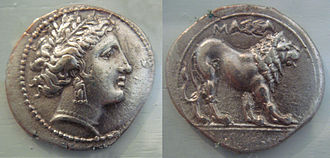
A silver drachma inscribed with MASSA[LIA] (ΜΑΣΣΑ[ΛΙΑ]), dated 375–200 BC, during the Hellenistic period of Marseille, bearing the head of the Greek goddess Artemis on the obverse and a lion on the reverse
Marseille was originally founded circa 600 BC as the Greek colony of Massalia and populated by settlers from Phocaea (modern Foça, Turkey). It became the preeminent Greek polis in the Hellenized region of southern Gaul. The city-state sided with the Roman Republic against Carthage during the Second Punic War (218-201 BC), retaining its independence and commercial empire throughout the western Mediterranean even as Rome expanded into Western Europe and North Africa. However, the city lost its independence following the Roman Siege of Massilia in 49 BC, during Caesar's Civil War, in which Massalia sided with the exiled faction at war with Julius Caesar.
Marseille continued to prosper as a Roman city, becoming an early center of Christianity during the Western Roman Empire. The city maintained its position as a premier maritime trading hub even after its capture by the Visigoths in the 5th century AD, although the city went into decline following the sack of 739 AD by the forces of Charles Martel. It became part of the County of Provence during the 10th century, although its renewed prosperity was curtailed by the Black Death of the 14th century and sack of the city by the Crown of Aragon in 1423. The city's fortunes rebounded with the ambitious building projects of René of Anjou, Count of Provence, who strengthened the city's fortifications during the mid-15th century. During the 16th century the city hosted a naval fleet with the combined forces of the Franco-Ottoman alliance, which threatened the ports and navies of Genoa and the Holy Roman Empire.
Marseille lost a significant portion of its population during the Great Plague of Marseille in 1720, but the population had recovered by mid century. In 1792 the city became a focal point of the French Revolution and was the birthplace of France's national anthem, La Marseillaise. The Industrial Revolution and establishment of the French Empire during the 19th century allowed for further expansion of the city, although it was occupied by the German Wehrmacht in November 1942 and subsequently heavily damaged during World War II. The city has since become a major center for immigrant communities from former French colonies, such as French Algeria.
Economy
Marseille is a major French centre for trade and industry, with excellent transportation infrastructure (roads, sea port and airport). Marseille Provence Airport, is the fourth largest in France. In May 2005, the French financial magazine L'Expansion named Marseille the most dynamic of France's large cities, citing figures showing that 7,200 companies had been created in the city since 2000.[13] Marseille is also France's second largest research centre with 3,000 research scientists within Aix Marseille University.[citation needed]
As of 2014[update], the Marseille metropolitan area had a GDP amounting to $60.3 billion, or $36,127 per capita (purchasing power parity).[14]
Port
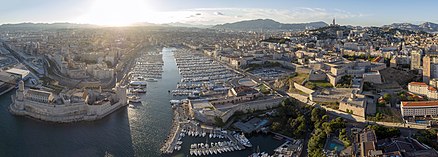
The entrance to the Old Port, flanked by Fort Saint-Jean and Fort Saint-Nicolas
Historically, the economy of Marseille was dominated by its role as a port of the French Empire, linking the North African colonies of Algeria, Morocco and Tunisia with Metropolitan France. The Old Port was replaced as the main port for trade by the Port de la Joliette during the Second Empire and now contains restaurants, offices, bars and hotels and functions mostly as a private marina. The majority of the port and docks, which experienced decline in the 1970s after the oil crisis, have been recently redeveloped with funds from the European Union. Fishing remains important in Marseille and the food economy of Marseille is fed by the local catch; a daily fish market is still held on the Quai des Belges of the Old Port.
The economy of Marseille and its region is still linked to its commercial port, the first French port and the fifth European port by cargo tonnage, which lies north of the Old Port and eastern in Fos-sur-Mer. Some 45,000 jobs are linked to the port activities and it represents 4 billion euros added value to the regional economy.[15] 100 million tons of freight pass annually through the port, 60% of which is petroleum, making it number one in France and the Mediterranean and number three in Europe. However, in the early 2000s, the growth in container traffic was being stifled by the constant strikes and social upheaval.[16] The port is among the 20th firsts in Europe for container traffic with 1,062,408 TEU and new infrastructures have already raised the capacity to 2M TEU.[17] Petroleum refining and shipbuilding are the principal industries, but chemicals, soap, glass, sugar, building materials, plastics, textiles, olive oil, and processed foods are also important products.[citation needed] Marseille is connected with the Rhône via a canal and thus has access to the extensive waterway network of France. Petroleum is shipped northward to the Paris basin by pipeline. The city also serves as France's leading centre of oil refining.
Companies, services and high technologies

From left to right: La Joliette neighbourhood (old docks), ferry ship docks, new port, Euroméditerranée business district (CMA CGM Tower) and surrounding areas
In recent years, the city has also experienced a large growth in service sector employment and a switch from light manufacturing to a cultural, high-tech economy.[citation needed] The Marseille region is home to thousands of companies, 90% of which are small and medium enterprises with less than 500 employees.[18][full citation needed] Among the most famous ones are CMA CGM, container-shipping giant; Compagnie maritime d'expertises (Comex), world leader in sub-sea engineering and hydraulic systems; Airbus Helicopters, an Airbus division; Azur Promotel, an active real estate development company; La Provence, the local daily newspaper; RTM, Marseille's public transport company; and Société Nationale Maritime Corse Méditerranée (SNCM), a major operator in passenger, vehicle and freight transportation in the Western Mediterranean. The urban operation Euroméditerranée has developed a large offer of offices and thus Marseille hosts one of the main business district in France.
Marseille is the home of three main technopoles: Château-Gombert (technological innovations), Luminy (biotechnology) and La Belle de Mai (17,000 sq.m. of offices dedicated to multimedia activities).[19][20]
Tourism and attractions

Pointe Rouge Beach

Palais du Pharo
The port is also an important arrival base for millions of people each year, with 2.4 million including 890,100 from cruise ships.[15]
With its beaches, history, architecture and culture (24 museums and 42 theatres), Marseille is one of the most visited cities in France, with 4.1 million visitors in 2012.[21]
Marseille is ranked 86th in the world for business tourism and events, advancing from the 150th spot one year before.[citation needed] The number of congress days hosted on its territory increased from 109,000 in 1996 to almost 300,000 in 2011.[citation needed]
They take place in three main sites, the Palais du Pharo, Palais des Congrès et des Expositions (Parc Chanot) and World Trade Center.[22] In 2012 Marseille hosted the World Water Forum.
Several urban projects have been developed to make Marseille attractive. Thus new parks, museums, public spaces and real estate projects aim to improve the city's quality of life (Parc du 26e Centenaire, Old Port of Marseille,[23] numerous places in Euroméditerranée) to attract firms and people. Marseille municipality acts to develop Marseille as a regional nexus for entertainment in the south of France with high concentration of museums, cinemas, theatres, clubs, bars, restaurants, fashion shops, hotels, and art galleries.
Employment
Unemployment in the economy fell from 20% in 1995 to 14% in 2004.[24] However, Marseille unemployment rate remains higher than the national average. In some parts of Marseille, youth unemployment is reported to be as high as 40%.[25]
Administration
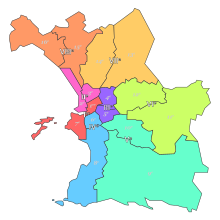
The sectors and arrondissements of Marseille
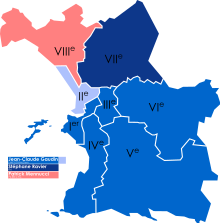
Political majority in each sector since 2014
The city of Marseille is divided into 16 municipal arrondissements, which are themselves informally divided into 111 neighbourhoods (French: quartiers). The arrondissements are regrouped in pairs, into 8 sectors, each with a mayor and council (like the arrondissements in Paris and Lyon).[26] Municipal elections are held every six years and are carried out by sector. There are 303 councilmembers in total, two-thirds sitting in the sector councils and one third in the city council.
The 9th arrondissement of Marseille is the largest in terms of area because it comprises parts of Calanques National Park. With a population of 89,316 (2007), the 13th arrondissement of Marseille is the most populous one.
From 1950 to the mid-1990s, Marseille was a Socialist (PS) and Communist (PCF) stronghold. Gaston Defferre (PS) was consecutively reelected six times as Mayor of Marseille from 1953 until his death in 1986. He was succeeded by Robert Vigouroux of the European Democratic and Social Rally (RDSE). Jean-Claude Gaudin of the right-wing UMP was elected Mayor of Marseille in 1995. Gaudin was reelected in 2001, 2008 and 2014.
In recent years, the Communist Party has lost most of its strength in the northern boroughs of the city, whereas the National Front has received significant support. At the last municipal election in 2014, Marseille was divided between the northern arrondissements dominated by the left (PS) and far-right (FN) and the southern part of town dominated by the right-wing (UMP). Marseille is also divided in twelve cantons, each of them sending two members to the Departmental Council of the Bouches-du-Rhône department.
List of Mayors of Marseille since the beginning of the 20th century

Gaston Defferre served as Mayor of Marseille from 1953 to 1986.

Jean-Claude Gaudin has been Mayor of Marseille since 1995.
| Mayor | Term start | Term end | | Party |
|---|---|---|---|---|
Siméon Flaissières | 1895 | 1901 | Socialist | |
| Marius-Justin-Albin-Hector Curet | 1901 | 1902 | Independent | |
Jean-Baptiste-Amable Chanot | 1902 | 1908 | Progressive Republican | |
| Emmanuel Allard | 1908 | 1910 | Progressive Republican | |
Clément Lévy | 1910 | 1910 | Independent | |
Bernard Cadenat | 1910 | 1912 | SFIO | |
Jean-Baptiste-Amable Chanot | 1912 | 1914 | Progressive Republican | |
Eugène Pierre | 1914 | 1919 | Republican Independents | |
Siméon Flaissières | 1919 | 1931 | SFIO | |
Simon Sabiani | 1931 | 1931 | Republican Independents | |
Georges Ribot | 1931 | 1935 | Radical | |
Henri Tasso | 1931 | 1939 | SFIO | |
| Nominated administrators | 1939 | 1944 | ||
Gaston Defferre | 1944 | 1946 | SFIO | |
| Marcel Renault | 1946 | 1946 | Independent | |
Jean Cristofol | 1946 | 1947 | PCF | |
Michel Carlini | 1947 | 1953 | RPF | |
Gaston Defferre | 1953 | 1986 | SFIO, PS | |
Jean-Victor Cordonnier | 1986 | 1986 | PS | |
Robert Vigouroux | 1986 | 1995 | DVG | |
Jean-Claude Gaudin | 1995 | incumbent | DL, UMP |
Population
This section may be in need of reorganization to comply with Wikipedia's layout guidelines. (June 2017) (Learn how and when to remove this template message) |
| Historical population | ||
|---|---|---|
| Year | Pop. | ±% p.a. |
| 1801 | 111,100 | — |
| 1851 | 195,350 | +1.14% |
| 1881 | 360,100 | +2.06% |
| 1911 | 550,619 | +1.43% |
| 1931 | 606,000 | +0.48% |
| 1946 | 636,300 | +0.33% |
| 1954 | 661,407 | +0.48% |
| 1962 | 778,071 | +2.05% |
| 1968 | 889,029 | +2.25% |
| 1975 | 908,600 | +0.31% |
| 1982 | 874,436 | −0.55% |
| 1990 | 800,550 | −1.10% |
| 1999 | 798,430 | −0.03% |
| 2006 | 839,043 | +0.71% |
| 2011 | 850,636 | +0.27% |
Immigration
Because of its pre-eminence as a Mediterranean port, Marseille has always been one of the main gateways into France. This has attracted many immigrants and made Marseille a cosmopolitan melting pot. By the end of the 18th century about half the population originated from elsewhere in Provence mostly and also from southern France.[27][28][page needed]
Economic conditions and political unrest in Europe and the rest of the world brought several other waves of immigrants during the 20th century: Greeks and Italians started arriving at the end of the 19th century and in the first half of the 20th century, up to 40% of the city's population was of Italian origin;[29] Russians in 1917; Armenians in 1915 and 1923; Vietnamese in the 1920s, 1954 and after 1975;[30]Corsicans during the 1920s and 1930s; Spanish after 1936; North Africans (both Arab and Berber) in the inter-war period; Sub-Saharan Africans after 1945; the pieds-noirs from the former French Algeria in 1962; and then from Comoros. In 2006, it was reported that 70,000 city residents were considered to be of Maghrebi origin, mostly from Algeria. The second largest group in Marseille in terms of single nationalities were from the Comoros, amounting to some 45,000 people.[29]
Currently, over one third of the population of Marseille can trace their roots back to Italy.[31] Marseille also has the second-largest Corsican and Armenian populations of France. Other significant communities include Maghrebis, Turks, Comorians, Chinese, and Vietnamese.[32]
In 1999, in several arrondissements, about 40% of the young people under 18 were of Maghrebi origin (at least one immigrant parent).[33]
Since 2013 immigrants from Eastern Europe travel to work in the city of Marseille, attracted by better job opportunities and the good climate of this Mediterranean city. The main nationalities are Romanians and Poles.[34]
Largest groups of foreign residents | |
| Nationality | Population (2011)[35] |
|---|---|
| 37,673 | |
| 32,800 | |
| 30,000 | |
| 12,283 | |
| 9,094 | |
| 8,227 | |
| 7,134 | |
| 6,988 | |
| 5,002 | |
| 4,902 | |
| ||||||||||||||||||
| |||||||||||||||||||
Religion
Major religious communities in Marseille include:
- Roman Catholic (400,000)
- Muslim (200,000)
- Armenian Apostolic (80,000)
- Jewish (52,000)
- Protestant (20,000)
- Eastern Orthodox (10,000)
- Hindu (4,000)
- Buddhist (3,000).[36]
Culture

Paul Cézanne's The Bay of Marseille, Seen from L'Estaque

Bastille Day military parade in Marseille, 2012
Marseille is a city that has its own unique culture and is proud of its differences from the rest of France.[37] Today it is a regional centre for culture and entertainment with an important opera house, historical and maritime museums, five art galleries and numerous cinemas, clubs, bars and restaurants.
Marseille has a large number of theatres, including La Criée, Le Gymnase and the Théâtre Toursky. There is also an extensive arts centre in La Friche, a former match factory behind the Sainst-Charles station. The Alcazar, until the 1960s a well known music hall and variety theatre, has recently been completely remodelled behind its original façade and now houses the central municipal library.[38] Other music venues in Marseille include Le Silo (also a theatre) and GRIM.
Marseille has also been important in the arts. It has been the birthplace and home of many French writers and poets, including Victor Gélu, Valère Bernard, Pierre Bertas,[39]Edmond Rostand and André Roussin. The small port of l'Estaque on the far end of the Bay of Marseille became a favourite haunt for artists, including Auguste Renoir, Paul Cézanne (who frequently visited from his home in Aix), Georges Braque and Raoul Dufy.
European Capital of Culture
Marseille served as the European Capital of Culture for 2013 along with Košice.[40]Marseille-Provence 2013 (MP2013) featured more than 900 cultural events held throughout Marseille and the surrounding communities. These cultural events generated more than 11 million visits.[41] The European Capital of Culture was also the occasion to unveil more than 600 million euros in new cultural infrastructure in Marseille and its environs, including the iconic MuCEM designed by Rudy Ricciotti.
Tarot de Marseille
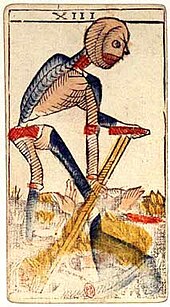
Marseille tarot card
The most commonly used tarot deck takes its name from the city; it has been called the Tarot de Marseille since the 1930s—a name coined for commercial use by the French cardmaker and cartomancer Paul Marteau, owner of B–P Grimaud. Previously this deck was called Tarot italien (Italian Tarot) and even earlier it was simply called Tarot. Before being de Marseille, it was used to play the local variant of tarocchi before it became used in cartomancy at the end of the 18th century, following the trend set by Antoine Court de Gébelin. The name Tarot de Marseille (Marteau used the name ancien Tarot de Marseille) was used by contrast to other types of Tarots such as Tarot de Besançon; those names were simply associated with cities where there were many cardmakers in the 18th century (previously several cities in France were involved in cardmaking).[42]
Another local tradition is the making of santons, small hand-crafted figurines for the traditional Provençal Christmas creche. Since 1803, starting on the last Sunday of November, there has been a Santon Fair in Marseille; it is currently held in the Cours d'Estienne d'Orves, a large square off the Vieux-Port.
Opera

The Opéra de Marseille
Marseille's main cultural attraction was, since its creation at the end of the 18th century and until the late 1970s, the Opéra. Located near the Old Port and the Canebière, at the very heart of the city, its architectural style was comparable to the classical trend found in other opera houses built at the same time in Lyon and Bordeaux. In 1919, a fire almost completely destroyed the house, leaving only the stone colonnade and peristyle from the original façade.[43][44] The classical façade was restored and the opera house reconstructed in a predominantly Art Deco style, as the result of a major competition. Currently the Opéra de Marseille stages six or seven operas each year.[45]
Since 1972, the Ballet national de Marseille has performed at the opera house; its director from its foundation to 1998 was Roland Petit.
Popular events and festivals
There are several popular festivals in different neighborhoods, with concerts, animations, and outdoor bars, like the Fête du Panier in June. On 21 June, there are dozens of free concerts in the city as part of France's Fête de la Musique, featuring music from all over the world. Being free events, many Marseille residents attend.
Marseille hosts a Gay Pride event in early July. In 2013, Marseille hosted Europride, an international LGBT event, 10 July–20.[46] At the beginning of July, there is the International Documentary Festival.[47]
At the end of September, the electronic music festival Marsatac takes place.
In October, the Fiesta des Suds offers many concerts of world music.[48]
Hip hop music
Marseille is also well known in France for its hip hop music.[49] Bands like IAM originated from Marseille and initiated the rap phenomenon in France. Other known groups include Fonky Family, Psy 4 de la Rime (including rappers Soprano and Alonzo), and Keny Arkana.
In a slightly different way, ragga music is represented by Massilia Sound System.
Food

Traditional Marseille bouillabaisse

Swordfish in olive oil with ratatouille and saffron rice

Pieds paquets
Bouillabaisse is the most famous seafood dish of Marseille. It is a fish stew containing at least three varieties of very fresh local fish: typically red rascasse (Scorpaena scrofa); sea robin (fr: grondin); and European conger (fr: congre).[50] It can include gilt-head bream (fr: dorade); turbot; monkfish (fr: lotte or baudroie); mullet; or silver hake (fr: merlan), and it usually includes shellfish and other seafood such as sea urchins (fr: oursins), mussels (fr: moules); velvet crabs (fr: étrilles); spider crab (fr: araignées de mer), plus potatoes and vegetables. In the traditional version, the fish is served on a platter separate from the broth.[51] The broth is served with rouille, a mayonnaise made with egg yolk, olive oil, red bell pepper, saffron, and garlic, spread on pieces of toasted bread, or croûtes.[52][53] In Marseille, bouillabaisse is rarely made for fewer than ten people; the more people who share the meal, and the more different fish that are included, the better the bouillabaisse.[54]
Aïoli is a sauce made from raw garlic, lemon juice, eggs and olive oil, served with boiled fish, hard boiled eggs and cooked vegetables.[52]
Anchoïade is a paste made from anchovies, garlic, and olive oil, spread on bread or served with raw vegetables.[52]
Bourride is a soup made with white fish (monkfish, European sea bass, whiting, etc.) and aïoli.[55]
Fougasse is a flat Provençal bread, similar to the Italian focaccia. It is traditionally baked in a wood oven and sometimes filled with olives, cheese or anchovies.[citation needed]
Navette de Marseille are, in the words of food writer M. F. K. Fisher, "little boat-shaped cookies, tough dough tasting vaguely of orange peel, smelling better than they are."[56]
Farinata#French variations is chickpea flour boiled into a thick mush, allowed to firm up, then cut into blocks and fried.[57]
Pastis is an alcoholic beverage made with aniseed and spice. It is extremely popular in the region.[58]
Pieds paquets is a dish prepared from sheep's feet and offal.[55]
Pistou is a combination of crushed fresh basil and garlic with olive oil, similar to the Italian pesto. Soup au pistou combines pistou in a broth with pasta and vegetables.[52]
Tapenade is a paste made from chopped olives, capers, and olive oil (sometimes anchovies may be added).[59]
Films set in Marseille
Marseille has been the setting for many films, mostly produced in France or Hollywood. Taxi 4 was filmed in Marseille (2007)
Marseille in television
The French television series Plus belle la vie is set in an imaginary quarter, Le Mistral, of Marseille. It is filmed in the Panier quarter of Marseille.
The Netflix series Marseille is set in the city in the 2010s.
Main sights
Marseille is listed as a major centre of art and history. The city has many museums and galleries and there are many ancient buildings and churches of historical interest.
Central Marseille

Le Panier quarter with the Hotel de Ville and the church of Notre-Dame des Accoules

La Vieille Charité
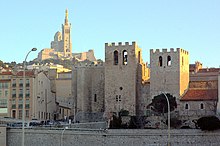
The Abbey of St. Victor and the basilica of Notre-Dame de la Garde
Most of the attractions of Marseille (including shopping areas) are located in the 1st, 2nd, 6th and 7th arrondissements. These include:[60][61]
- The Old Port or Vieux-Port, the main harbour and marina of the city. It is guarded by two massive forts (Fort Saint-Nicolas and Fort Saint-Jean) and is one of the main places to eat in the city. Dozens of cafés line the waterfront. The Quai des Belges at the end of the harbour is the site of the daily fish market. Much of the northern quayside area was rebuilt by the architect Fernand Pouillon after its destruction by the Nazis in 1943.
- The Hôtel de Ville (City Hall), a baroque building dating from the 17th century.
- The Centre Bourse and the adjacent Rue St Ferreol district (including Rue de Rome and Rue Paradis), the main shopping area in central Marseille.
- The Porte d'Aix, a triumphal arch commemorating French victories in the Spanish Expedition.
- The Hôtel-Dieu, a former hospital in Le Panier, transformed into an InterContinental hotel in 2013.
La Vieille Charité in Le Panier, an architecturally significant building designed by the Puget brothers. The central baroque chapel is situated in a courtyard lined with arcaded galleries. Originally built as an alms house, it is now home to an archeological museum and a gallery of African and Asian art, as well as bookshops and a café. It also houses the Marseille International Poetry Centre.[62]- The Cathedral of Sainte-Marie-Majeure or La Major, founded in the 4th century, enlarged in the 11th century and completely rebuilt in the second half of the 19th century by the architects Léon Vaudoyer and Henri-Jacques Espérandieu. The present day cathedral is a gigantic edifice in Romano-Byzantine style. A romanesque transept, choir and altar survive from the older medieval cathedral, spared from complete destruction only as a result of public protests at the time.
- The 12th-century parish church of Saint-Laurent and adjoining 17th-century chapel of Sainte-Catherine, on the quayside near the Cathedral.
- The Abbey of Saint-Victor, one of the oldest places of Christian worship in Europe. Its 5th-century crypt and catacombs occupy the site of a Hellenic burial ground, later used for Christian martyrs and venerated ever since. Continuing a medieval tradition,[63] every year at Candlemas a Black Madonna from the crypt is carried in procession along Rue Sainte for a blessing from the archbishop, followed by a mass and the distribution of "navettes" and green votive candles.
Museums
In addition to the two in the Centre de la Vieille Charité, described above, the main museums are:[64]
- The Musée des Civilisations de l'Europe et de la Méditerranée (MuCEM) and the Villa Méditerranée were inaugurated in 2013. The MuCEM is devoted to the history and culture of European and Mediterranean civilisations. The adjacent Villa Méditerranée, an international centre for cultural and artistic interchange, is partially constructed underwater. The site is linked by footbridges to the Fort Saint-Jean and to the Panier.[65][66]
- The Musée Regards de Provence, opened in 2013, is located between the Cathedral of Notre Dame de la Majeur and the Fort Saint-Jean. It occupies a converted port building constructed in 1945 to monitor and control potential sea-borne health hazards, in particular epidemics. It now houses a permanent collection of historical artworks from Provence as well as temporary exhibitions.[67]
- The Musée du Vieux Marseille, housed in the 16th-century Maison Diamantée, describing everyday life in Marseille from the 18th century onwards.
- The Musée des Docks Romains preserves in situ the remains of Roman commercial warehouses, and has a small collection of objects, dating from the Greek period to the Middle Ages, that were uncovered on the site or retrieved from shipwrecks.
- The Marseille History Museum (Musée d'Histoire de Marseille), devoted to the history of the town, located in the Centre Bourse. It contains remains of the Greek, and Roman history of Marseille as well as the best preserved hull of a 6th-century boat in the world. Ancient remains from the Hellenic port are displayed in the adjacent archeological gardens, the Jardin des Vestiges.
- The Musée Cantini, a museum of modern art near the Palais de Justice. It houses artworks associated with Marseille as well as several works by Picasso.
- The Musée Grobet-Labadié, opposite the Palais Longchamp, houses an exceptional collection of European objets d'art and old musical instruments.
- The 19th-century Palais Longchamp, designed by Esperandieu, is located in the Parc Longchamp. Built on a grand scale, this italianate colonnaded building rises up behind a vast monumental fountain with cascading waterfalls. The jeux d'eau marks and masks the entry point of the Canal de Provence into Marseille. Its two wings house the Musée des beaux-arts de Marseille (a fine arts museum), and the Natural History Museum (Muséum d'histoire naturelle de Marseille).
- The Château Borély is located in the Parc Borély, a park off the Bay of Marseille with the Jardin botanique E.M. Heckel, a botanical garden. The Museum of the Decorative Arts, Fashion and Ceramics opened in the renovated château in June 2013.[68]
- The Musée d'Art Contemporain de Marseille (MAC), a museum of contemporary art, opened in 1994. It is devoted to American and European art from the 1960s to the present day.[69]
- The Musée du Terroir Marseillais in Château-Gombert, devoted to Provençal crafts and traditions.[70]
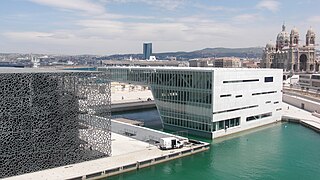
The MuCEM, Musée Regards de Provence and Villa Mediterannée, with Notre Dame de la Majeur on the right
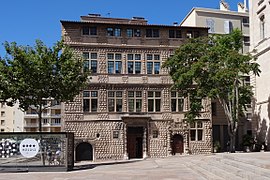
The sixteenth century Maison Diamantée which houses the Musée du Vieux Marseille
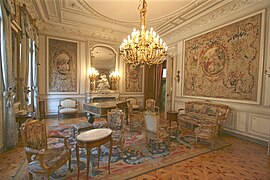
The music room in the Grobet-Labadié museum
The Palais Longchamp with its monumental fountain
Outside central Marseille
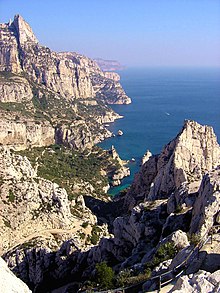
The Calanque of Sugiton in the 9th arrondissement of Marseille

The Château d'If
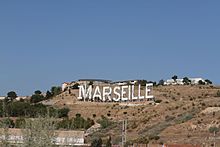
Hollywood-style "Marseille" sign
The main attractions outside the city centre include:[61]
- The 19th-century Basilica of Notre-Dame de la Garde, an enormous Romano-Byzantine basilica built by architect Espérandieu in the hills to the south of the Old Port. The terrace offers spectacular panoramic views of Marseille and its surroundings.[71]
- The Stade Vélodrome, the home stadium of the city's main football team, Olympique de Marseille.
- The Unité d'Habitation, an influential and iconic modernist building designed by the Swiss architect Le Corbusier in 1952. On the third floor is the gastronomic restaurant, Le Ventre de l'Architecte. On the roof is the contemporary gallery MaMo opened in 2013.
- The Docks de Marseille, a 19th-century warehouse transformed into offices.[72]
- The Pharo Gardens, a park with views of the Mediterranean and the Old Port.[73]
- The Corniche, a picturesque waterfront road between the Old Port and the Bay of Marseille.[73]
- The beaches at the Prado, Pointe Rouge, Les Goudes, Callelongue and Le Prophète.[74]
- The Calanques, a wild mountainous coastal area of outstanding natural beauty accessible from Callelongue, Sormiou, Morgiou, Luminy, and Cassis. Calanques National Park became France's tenth national park in 2012.[75][76]
- The islands of the Frioul archipelago in the Bay of Marseille, accessible by ferry from the Old Port. The prison of Château d'If was one of the settings for The Count of Monte Cristo, the novel by Alexandre Dumas.[77] The neighbouring islands of Ratonneau and Pomègues are joined by a man-made breakwater. The site of a former garrison and quarantine hospital, these islands are also of interest for their marine wildlife.
Education and research
A number of the faculties of the three universities that comprise Aix-Marseille University are located in Marseille:
- Université de Provence Aix-Marseille I
- Université de la Méditerranée Aix-Marseille II
- Université Paul Cézanne Aix-Marseille III
In addition Marseille has three grandes écoles:
Ecole Centrale de Marseille part of Centrale Graduate School- École pour l'informatique et les nouvelles technologies
- KEDGE Business School
The main French research bodies including the CNRS, INSERM and INRA are all well represented in Marseille. Scientific research is concentrated at several sites across the city, including Luminy, where there are institutes in developmental biology (the IBDML), immunology (CIML), marine sciences and neurobiology (INMED), at the CNRS Joseph Aiguier campus (a world-renowned institute of molecular and environmental microbiology) and at the Timone hospital site (known for work in medical microbiology). Marseille is also home to the headquarters of the IRD, which promotes research into questions affecting developing countries.
Transport

Motorways around Marseille
International and regional transport

Marseille Provence Airport, the fifth busiest in France.
The city is served by an international airport, Marseille Provence Airport, located in Marignane. The airport is the fifth busiest French airport, and known the 4th most important European traffic growth in 2012.[78] An extensive network of motorways connects Marseille to the north and west (A7), Aix-en-Provence in the north (A51), Toulon (A50) and the French Riviera (A8) to the east.
Gare de Marseille Saint-Charles is Marseille's main railway station. It operates direct regional services to Aix-en-Provence, Briançon, Toulon, Avignon, Nice, Montpellier, Toulouse, Bordeaux, Nantes, etc. Gare Saint-Charles is also one of the main terminal stations for the TGV in the south of France making Marseille reachable in three hours from Paris (a distance of over 750 km) and just over one and a half hours from Lyon. There are also direct TGV lines to Lille, Brussels, Nantes, Geneva, Strasbourg and Frankfurt as well as Eurostar services to London. In addition, the night train (Intercités de Nuit) from Luxembourg and Strasbourg stops here on its way to Nice, whereas the night train from Paris to Nice serves the Gare de Marseille-Blancarde.
There is a new long distance bus station adjacent to new modern extension to the Gare Saint-Charles with destinations mostly to other Bouches-du-Rhône towns, including buses to Aix-en-Provence, Cassis, La Ciotat and Aubagne. The city is also served with 11 other regional trains stations in the east and the north of the city.
Marseille has a large ferry terminal, the Gare Maritime, with services to
Corsica, Sardinia, Algeria and Tunisia.
Public transport

Metro and tramway network
Marseille is connected by the Marseille Métro train system operated by the Régie des transports de Marseille (RTM). It consists of two lines: Line 1 (blue) between Castellane and La Rose opened in 1977 and Line 2 (red) between Sainte-Marguerite-Dromel and Bougainville opened between 1984 and 1987. An extension of the Line 1 from Castellane to La Timone was completed in 1992, another extension from La Timone to La Fourragère (2.5 km (1.6 mi) and 4 new stations) was opened in May 2010. The Métro system operates on a turnstile system, with tickets purchased at the nearby adjacent automated booths. Both lines of the Métro intersect at Gare Saint-Charles and Castellane. Three bus rapid transit lines are under construction to better connect the Métro to farther places (Castellane -> Luminy ; Capitaine Gèze – La Cabucelle -> Vallon des Tuves ; La Rose -> Château Gombert – Saint Jérome).

The new tramway
An extensive bus network serves the city and suburbs of Marseille, with 104 lines and 633 buses. The three lines of the tramway,[79] opened in 2007, go from the CMA CGM Tower towards Les Caillols.
As in many other French cities, a bike-sharing service nicknamed "Le vélo", free for trips of less than half an hour, was introduced by the city council in 2007.[80]
A free ferry service operates between the two opposite quays of the Old Port. From 2011 ferry shuttle services operate between the Old Port and Pointe Rouge; in spring 2013 it will also run to l'Estaque.[81] There are also ferry services and boat trips available from the Old Port to Frioul, the Calanques and Cassis.
Sport

The Stade Vélodrome, home of Olympique de Marseille
The city boasts a wide variety of sports facilities and teams. The most popular team is the city's football club, Olympique de Marseille, which was the finalist of the UEFA Champions League in 1991, before winning the competition in 1993. The club also became finalists of the UEFA Europa League in 1999, 2004 and 2018. The club had a history of success under then-owner Bernard Tapie. The club's home, the Stade Vélodrome, which can seat around 67,000 people, also functions for other local sports, as well as the national rugby team. Stade Velodrome hosted a number of games during the 1998 FIFA World Cup, 2007 Rugby World Cup, and UEFA Euro 2016. The local rugby teams are Marseille XIII and Marseille Vitrolles Rugby.[citation needed]
Marseille is famous for its important pétanque activity, it is even renowned as the pétanque capitale.[82] In 2012 Marseille hosted the Pétanque World Championship and the city hosts every year the Mondial la Marseillaise de pétanque, the main pétanque competition.
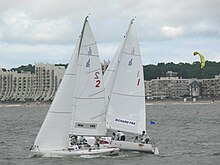
Match Race France 2008
Sailing is a major sport in Marseille. The wind conditions allow regattas in the warm waters of the Mediterranean.[citation needed] Throughout most seasons of the year it can be windy while the sea remains smooth enough to allow sailing. Marseille has been the host of 8 (2010) Match Race France events which are part of the World Match Racing Tour. The event draws the world's best sailing teams to Marseille. The identical supplied boats (J Boats J-80 racing yachts) are raced two at a time in an on the water dogfight which tests the sailors and skippers to the limits of their physical abilities.
Points accrued count towards the World Match Racing Tour and a place in the final event, with the overall winner taking the title ISAF World Match Racing Tour Champion. Match racing is an ideal sport for spectators in Marseille, as racing in close proximity to the shore provides excellent views. The city was also considered as a possible venue for 2007 America's Cup.[83]
Marseille is also a place for other water sports such as windsurfing and powerboating. Marseille has three golf courses. The city has dozens of gyms and several public swimming pools. Running is also popular in many of Marseille's parks such as Le Pharo and Le Jardin Pierre Puget. An annual footrace is held between the city and neighbouring Cassis: the Marseille-Cassis Classique Internationale.[citation needed]
Notable people

Honoré Daumier: Sunday at the Museum

Edmond Rostand

Memorial to Eliane Plewman in Dachau concentration camp

Jean-Pierre Rampal

Zinedine Zidane
Marseille was the birthplace of:
Pytheas (fl. 4th century BC), Greek merchant, geographer and explorer
Petronius (fl. 1st century AD), Roman novelist and satirist
Pierre Demours (1702–1795), physician
Jean-Henri Gourgaud, aka. "Dugazon" (1746–1809), actor
Jean-Baptiste Benoît Eyriès (1767–1846), geographer, author and translator
Désirée Clary (1777–1860), wife of King Carl XIV Johan of Sweden, and therefore Queen Desirée or Queen Desideria of Sweden
Sabin Berthelot (1794–1880), naturalist and ethnologist
Adolphe Thiers (1797–1877), first president of the Third Republic
Étienne Joseph Louis Garnier-Pages (1801–1841), politician
Honoré Daumier (1808–1879), caricaturist and painter
Joseph Autran (1813–1877), poet
Charles-Joseph-Eugene de Mazenod (1782–1861), bishop of Marseille and founder of the Missionary Oblates of Mary Immaculate.
Lucien Petipa (1815–1898), ballet dancer
Joseph Mascarel (1816–1899), mayor of Los Angeles
Marius Petipa (1818–1910), ballet dancer and choreographer
Ernest Reyer (1823–1909), opera composer and music critic
Olivier Émile Ollivier (1825–1913), statesman
Victor Maurel (1848–1923), operatic baritone- Joseph Pujol, aka. "Le Pétomane" (1857–1945), entertainer
Charles Fabry (1867–1945), physicist
Edmond Rostand (1868–1918), poet and dramatist
Pavlos Melas (1870–1904), Greek army officer
Louis Nattero, (1870–1915), painter
Vincent Scotto (1876–1952), guitarist, songwriter[84]
Charles Camoin (1879–1965), fauvist painter
Henri Fabre (1882–1984), aviator and inventor of the first seaplane
Frédéric Mariotti (1883–1971), actor
Darius Milhaud (1892–1974), composer and teacher[85][86]
Berty Albrecht (1893–1943), French Resistance, Croix de Guerre
Antonin Artaud (1897–1948), author
Henri Tomasi (1901–1971), composer and conductor
Zino Francescatti (1902–1991), violinist
Fernandel (1903–1971), actor
Marie-Madeleine Fourcade (1909–1989), French Resistance, Commander of the Légion d'honneur
Éliane Browne-Bartroli (Eliane Plewman, 1917–1944), French Resistance, Croix de Guerre
César Baldaccini (1921–1998), sculptor
Louis Jourdan (1921–2015), actor
Jean-Pierre Rampal (1922–2000), flautist
Alice Colonieu, (1924–2010), ceramist
Paul Mauriat (1925–2006), orchestra leader, composer
Maurice Béjart (1927–2007), ballet choreographer
Régine Crespin (1927–2007), opera singer
Ginette Garcin (1928–2010), actor- André di Fusco (1932–2001), known as André Pascal, songwriter, composer
Henry de Lumley (born 1934), archaeologist
Sacha Sosno (1937–2013), sculptor
Jean-Pierre Ricard (born 1944), cardinal, archbishop of Bordeaux
Georges Chappe (born 1944), cyclist
Jean-Claude Izzo (1945–2000), author
Denis Ranque (born 1952), businessman
Ariane Ascaride (born 1954), actress
Myriam Fox-Jerusalmi (born 1961), world champion slalom canoer
Eric Cantona (born 1966), Manchester United and French national team football player
Patrick Fiori (born 1969), singer
Marc Panther (born 1970), member of the popular Japanese rock band Globe
Zinedine Zidane (born 1972), professional football player and former captain of the France national football team
Romain Barnier (born 1976), freestyle swimmer
Sébastien Grosjean (born 1978), tennis player
Philippe Echaroux (born 1983), photographer
Mathieu Flamini (born 1984), football player
Rémy Di Gregorio (born 1985), cyclist
Jessica Fox (born 1994), French-born Australian slalom canoer, Olympic silver (K-1 slalom), world championships bronze (C-1)[87]
 Play media
Play mediaNewsreel showing the murder of King Alexander of Yugoslavia and French Foreign Minister Louis Barthou in Marseille (October 1934).
The following personalities died in Marseille:
- Blessed Antoine Frédéric Ozanam, on 8 September 1853.
- French poet Arthur Rimbaud, on 10 November 1891.
Brice Meuleman, 2nd Catholic Archbishop of Calcutta, on 15 July 1924.- King Alexander I of Yugoslavia was assassinated on 9 October 1934 in Marseille along with French Foreign Minister Louis Barthou.
International relations
Sister cities
Marseille is currently officially twinned with 13 cities:[88]
 Abidjan, Côte d'Ivoire[88]
Abidjan, Côte d'Ivoire[88] Antwerp, Belgium[88]
Antwerp, Belgium[88] Copenhagen, Denmark[88]
Copenhagen, Denmark[88] Dakar, Senegal[88]
Dakar, Senegal[88] Genoa, Italy[88]
Genoa, Italy[88] Glasgow, United Kingdom[88]
Glasgow, United Kingdom[88] Haifa, Israel[88]
Haifa, Israel[88] Hamburg, Germany[88]
Hamburg, Germany[88] Kobe, Japan[88][89]
Kobe, Japan[88][89] Marrakech, Morocco[88]
Marrakech, Morocco[88] Odessa, Ukraine[88]
Odessa, Ukraine[88] Piraeus, Greece[88][90]
Piraeus, Greece[88][90] Shanghai, China[88]
Shanghai, China[88]
Partner cities
In addition, Marseille has signed various types of formal agreements of cooperation with 27 cities all over the world:[91]
 Agadir, Morocco (2003)[91]
Agadir, Morocco (2003)[91] Alexandria, Egypt (1990)[91]
Alexandria, Egypt (1990)[91] Algiers, Algeria (1980)[91]
Algiers, Algeria (1980)[91] Bamako, Mali (1991)[91]
Bamako, Mali (1991)[91] Barcelona, Spain (1998)[91]
Barcelona, Spain (1998)[91] Beirut, Lebanon (2003)[91]
Beirut, Lebanon (2003)[91] Casablanca, Morocco (1998)[91]
Casablanca, Morocco (1998)[91] Gdańsk, Poland (1992)[91][92]
Gdańsk, Poland (1992)[91][92] Istanbul, Turkey (2003)[91]
Istanbul, Turkey (2003)[91] Jerusalem, Israel (2006)[91]
Jerusalem, Israel (2006)[91] Limassol, Cyprus[93]
Limassol, Cyprus[93] Lomé, Togo (1995)[91]
Lomé, Togo (1995)[91] Lyon, France
Lyon, France Meknes, Morocco (1998)[91]
Meknes, Morocco (1998)[91] Montevideo, Uruguay (1999)[91]
Montevideo, Uruguay (1999)[91] Nice, France
Nice, France Nîmes, France
Nîmes, France Rabat, Morocco (1989)[91]
Rabat, Morocco (1989)[91] Saint Petersburg, Russia (2013)[91]
Saint Petersburg, Russia (2013)[91] Sarajevo, Bosnia-Herzegovina (2003)[91]
Sarajevo, Bosnia-Herzegovina (2003)[91] Thessaloniki, Greece[90]
Thessaloniki, Greece[90] Tirana, Albania (1991)[91][94]
Tirana, Albania (1991)[91][94] Tripoli, Libya (1991)[91]
Tripoli, Libya (1991)[91] Tunis, Tunisia (1998)[91]
Tunis, Tunisia (1998)[91] Valparaíso, Chile (2013)[91]
Valparaíso, Chile (2013)[91] Varna, Bulgaria (2007)[91]
Varna, Bulgaria (2007)[91] Yerevan, Armenia (1992)[91][95][96]
Yerevan, Armenia (1992)[91][95][96]
See also
 Marseille portal
Marseille portal- List of films set in Marseille
- Marcel Pagnol
- Marseille Marine Fire Battalion
- Marseille soap
References
Notes
^ ab "la Métropole d'Aix-Marseille-Provence, identité, compétences, financement". comersis. Retrieved 24 July 2018..mw-parser-output cite.citationfont-style:inherit.mw-parser-output qquotes:"""""""'""'".mw-parser-output code.cs1-codecolor:inherit;background:inherit;border:inherit;padding:inherit.mw-parser-output .cs1-lock-free abackground:url("//upload.wikimedia.org/wikipedia/commons/thumb/6/65/Lock-green.svg/9px-Lock-green.svg.png")no-repeat;background-position:right .1em center.mw-parser-output .cs1-lock-limited a,.mw-parser-output .cs1-lock-registration abackground:url("//upload.wikimedia.org/wikipedia/commons/thumb/d/d6/Lock-gray-alt-2.svg/9px-Lock-gray-alt-2.svg.png")no-repeat;background-position:right .1em center.mw-parser-output .cs1-lock-subscription abackground:url("//upload.wikimedia.org/wikipedia/commons/thumb/a/aa/Lock-red-alt-2.svg/9px-Lock-red-alt-2.svg.png")no-repeat;background-position:right .1em center.mw-parser-output .cs1-subscription,.mw-parser-output .cs1-registrationcolor:#555.mw-parser-output .cs1-subscription span,.mw-parser-output .cs1-registration spanborder-bottom:1px dotted;cursor:help.mw-parser-output .cs1-hidden-errordisplay:none;font-size:100%.mw-parser-output .cs1-visible-errorfont-size:100%.mw-parser-output .cs1-subscription,.mw-parser-output .cs1-registration,.mw-parser-output .cs1-formatfont-size:95%.mw-parser-output .cs1-kern-left,.mw-parser-output .cs1-kern-wl-leftpadding-left:0.2em.mw-parser-output .cs1-kern-right,.mw-parser-output .cs1-kern-wl-rightpadding-right:0.2em
^ "Évolution et structure de la population en 2014 − Unité urbaine de Marseille - Aix-en-Provence (00759) | Insee". www.insee.fr (in French).
^ ab "Insee – Territoire – Métropole Aix-Marseille Provence : Un territoire fragmenté, des solidarités à construire". insee.fr.
^ Also occasionally spelled Masalia.
^ Duchêne & Contrucci 1998, page needed A.
^ Ebel, Charles (1976). "Transalpine Gaul: the emergence of a Roman province". Brill Archive: 5–16. ISBN 90-04-04384-5., Chapter 2, Massilia and Rome before 390 B.C.
^ ab Michelin Guide to Provence,
ISBN 2-06-137503-0
^ Météo France, 1981–2010 averages
^ ab "Marseille–Obs (13)" (PDF). Fiche Climatologique: Statistiques 1981–2010 et records (in French). Meteo France. Archived from the original (PDF) on 10 March 2018. Retrieved 10 March 2018.
^ "Marignane (13)" (PDF). Fiche Climatologique: Statistiques 1981–2010 et records (in French). Meteo France. Archived from the original (PDF) on 10 March 2018. Retrieved 10 March 2018.
^ "Normes et records 1961–1990: Marseille-Marignane (Marseille Provence) (13) - altitude 5m" (in French). Infoclimat. Archived from the original on 3 March 2016. Retrieved 10 March 2018.
^ "Normales et records pour la période 1981-2010 à Marseille Observatoire Longchamp" (in French). Infoclimat. Archived from the original on 10 March 2018. Retrieved 10 March 2018.
^ Neumann, Benjamin (1 May 2005). "Les villes qui font bouger la France" [Cities That Are Moving France]. L'Express (in French). Paris: Roularta Media Group. Retrieved 28 January 2008.
^ Parilla, Joseph; Trujillo, Jesus Leal; Berube, Alan; Ran, Tao. "Global Metro Monitor". Brookings Institution. Retrieved 4 March 2015.
^ ab "Record Container Year as Marseilles Fos Sets Vision for Future" (PDF). Port of Marseilles Fos. 5 February 2013. Retrieved 8 March 2013.
^ "Les ports français" (PDF). Cour de comptes. Retrieved 5 January 2008.
^ "Marseille: Strategic Call for Arkas". Port Strategy. 11 April 2012. Retrieved 12 March 2013.
^ "Marseille Metropole Provence" (in French). Marseille-provence.com. Retrieved 1 February 2010.
^ "Technopôles". Marseille Provence Metropole. Archived from the original on 2 April 2015. Retrieved 12 March 2013.
^ "Marseilles Euroméditerranée: Between Europe and the Mediterranean" (PDF). Euroméditerranée. Etablissement Public d'Aménagement Euroméditerranée. p. 5. Retrieved 8 March 2003.
^ "Découvrir Marseille – Une ville de tourisme" (in French). Marseille.fr. 26 September 2004. Archived from the original on 11 May 2013. Retrieved 5 May 2013.
^ "Economie – Tourisme d'affaires et congrès" (in French). Marseille.fr. 26 September 2004. Archived from the original on 17 February 2013. Retrieved 12 March 2013.
^ Ravenscroft, Tom (5 March 2013). "Foster Unveils Reflective Events Pavilion in Marseille". Architects Journal. Retrieved 12 March 2013.
^ "Jean-Claude Gaudin: Sénateur-Maire de Marseille" (in French). Polytechnique.fr. 2 March 2004. Archived from the original on 30 December 2008. Retrieved 1 February 2010.
^ Kimmelman, Michael (19 December 2007). "In Marseille, Rap Helps Keep the Peace". The New York Times. Retrieved 12 May 2010.
^ "Mairies d'Arrondissements" (in French). Archived from the original on 5 January 2009. Retrieved 16 November 2007.
^ Liauzu 1996
^ Duchêne & Contrucci 1998, page needed E.
^ ab "Local0631EN:Quality0667EN" (PDF). Retrieved 8 July 2009.
^ Guillemin, Alain. "Les Vietnamiens a Marseille" (in French). Archived from the original on 23 March 2014.
^ Citoyenneté et intégration : Marseille, modèle d'intégration ?, report by Patrick Parodi, Académie d'Aix-Marseille.
^ "Diverse Marseille Spared in French Riots". Npr.org. 10 December 2005. Retrieved 1 February 2010.
^ Michèle Tribalat (2007). "Les concentrations ethniques en France" (PDF). Archived from the original (PDF) on 16 September 2011.
^ "Insee – Population – Les immigrés récemment arrivés en France – Une immigration de plus en plus européenne". insee.fr.
^ "Aire urbaine 2010 de Marseille – Aix-en-Provence (003) – NAT1 – Population par sexe, âge et nationalité – 2011". INSEE. Retrieved 2 June 2015.
^ "Marseille Espérance. All different, all Marseilles, Part II". France Diplomatie. Retrieved 10 April 2010.
[dead link]
^ Chris Kimble. "Marseille Culture". Marseillecityofculture.eu. Archived from the original on 1 May 2013. Retrieved 5 May 2013.
^ History of library[dead link]
^ "Pierre Bertas".
^ "Marseille Provence 2013: European Capital of Culture". Archived from the original on 26 August 2010.
^ "11 millions de visiteurs pour la capitale européenne de la culture". Retrieved 20 April 2015.
^ see:
Musée du Vieux-Marseille (2004), Cartes à jouer & tarots de Marseille: La donation Camoin, Alors Hors Du Temps, ISBN 2-9517932-7-8, official catalogue of the permanent collection of playing cards from the museum of Vieux-Marseille, including a detailed history of Tarot de Marseille Depaulis, Thierry (1984), Tarot, jeu et magie, Bibliothèque nationale, ISBN 2-7177-1699-8
^ "Opera in Genoa, Nice, Marseille, Montpellier, Barcelona". Capsuropera.com. Archived from the original on 23 December 2008. Retrieved 5 May 2009.
^ "Schmap Marseille Sights & Attractions – 6th arrond". Schmap.com. Retrieved 5 May 2009.
^ "Actualités". Opéra de Marseille (in French).
^ "Marseille 2013". EuroPride. Retrieved 20 April 2015.
^ "March 2013 Newsletter". FIDMarseille. Archived from the original on 7 October 2012. Retrieved 12 March 2013.
^ "octobre, 2012 – Dock des Suds : festivals, concerts de musique et location de salles à Marseille" (in French). Dock des Suds. Retrieved 12 March 2013.
^ "In Marseille, Rap Helps Keep the Peace", Article in New York Times, December 2007
Cannon, Steve; Dauncey, Hugh (2003), Popular music in France from chanson to techno: culture, identity, and society, Ashgate Publishing, pp. 194–198, ISBN 0-7546-0849-2
^ "La bouillabaisse classique doit comporter les 'trois poissons': rascasse, grondin, congre." Michelin Guide Vert -Côte dAzur, 1990, page 31
^ [1]|History and traditional recipe of bouillabaisse on the site of the Marseille Tourism Office
^ abcd David, Elizabeth (1999). French Provincial Cooking. Penguin Classics. ISBN 0-14-118153-2.
^ Wright, Clifford (2002). "Real Stew". Harvard Common Press. ISBN 1-55832-199-3.
^ Jean-Louis André, Cuisines des pays de France, Éditions du Chêne, 2001
^ ab Trott 2007, pp. 104.
^ Fisher, M. F. K. (1978). A Considerable Town. New York: Knopf. p. 150. ISBN 0-394-42711-4.
^ Root, Waverley (1992) [Originally published 1958]. The Food of France. New York: Vintage Books. p. 333. ISBN 0-679-73897-5.panisso, made either of chick-pea or maize flour, boiled into a sort of mush, then allowed to cool and become more solid, when it is fried.
^ Redman, Chris (5 June 2003). "Pass the Pastis". France Today.
^ Olney, Richard (1994). Lulu's Provenc̜al Table: the exuberant food and wine from Domaine Tempier Vineyard. New York: HarperCollins Publishers. p. 79. ISBN 0-06-016922-2.
^ Trott 2007, pp. 251–253.
^ ab "The Highlights". Office de tourisme Marseille.
^ "Présentation du CiPM". Centre international de la Poèsie, Marseille (CiPM) (in French).
^ "Christmas Time". Office de tourisme Marseille.
^ Trott 2007, pp. 264–267.
^ "MuCEM and J4". Office de tourisme Marseille. Retrieved 2 April 2015.
^ "Between the sky and the sea". Villa Méditerranée. Archived from the original on 3 April 2015. Retrieved 2 April 2015.
^ "Regards de Provence Museum". Musée Regards de Provence.
^ "Opening of the Château Borély, Musée des Arts Décoratifs, de la Faïence et de la Mode". Marseille-Provence 2013 European Capital of Culture. June 2013. Archived from the original on 4 April 2015. Retrieved 2 April 2015.
^ "Musée d'Art Contemporain de Marseille". Saatchi Gallery. Retrieved 5 May 2013.
^ Trott 2007, p. 225.
^ Trott 2007, pp. 256–257.
^ "The Docks". Office de tourisme Marseille. Retrieved 27 May 2015.
^ ab Trott 2007, pp. 261.
^ "The Beaches". Office de tourisme Marseille. Retrieved 27 May 2015.
^ Trott 2007, pp. 195–197.
^ "Origins of the Calanques National Park". Parc National des Calanques. Archived from the original on 23 September 2015. Retrieved 27 May 2015.
^ Trott 2007, pp. 267.
^ "Marseille-Provence bat tous les records avec 8,3 millions de passagers en 2012". Tourmag.com. Retrieved 12 March 2013.
^ "Official website of the Marseille tramway". Le-tram.fr. Retrieved 1 February 2010.
^ "Website for Le vélo" (in French). Levelo-mpm.fr. Retrieved 1 February 2010.
^ "Se déplacer – Navettes maritimes" (in French). Marseille.fr. 26 September 2004. Archived from the original on 17 February 2013. Retrieved 12 March 2013.
^ "Boules : Marseille capitale mondiale de la pétanque en 2012". La Provence. 14 December 2008. Retrieved 12 March 2013.
^ Eric Pape (3 July 2006). "Sailing to Success". Newsweek. Retrieved 5 May 2009.
^ "Scotto Opérettes Marseillaises Accord 4762107; Classical CD Reviews – November 2006 MusicWeb-International". Musicweb-international.com. Retrieved 5 May 2009.
^ Jessula, Georges (2003). "Darius Milhaud, Compositeur de Musique". Revue Juive: 140–144. Since their marriage in 1892, Milhaud's parents lived in the Bras d'Or in Aix-en-Provence, where their son grew up; however he was delivered at the home of his maternal grandparents in Marseille.
^ Milhaud, Darius (1998). "Ma Vie heureuse". Zurfluh. ISBN 2-87750-083-7.
^ "Jewish Australian kayaker Jessica Fox takes silver medal". Jewish Telegraphic Agency. Retrieved 20 April 2015.
^ abcdefghijklmn "Villes jumelées" (PDF). Site Officiel de la Ville de Marseille (in French). 20 July 2014. Retrieved 6 October 2015.
^ "Kobe's Sister Cities". Kobe Trade Information Office. Archived from the original on 21 April 2013. Retrieved 11 August 2013.
^ ab "Twinnings" (PDF). Central Union of Municipalities & Communities of Greece. Retrieved 25 August 2013.
^ abcdefghijklmnopqrstuvw "Accords de coopération" (PDF). Site Officiel de la Ville de Marseille (in French). Retrieved 6 October 2015.
^ "Gdańsk Official Website: 'Miasta partnerskie'" (in Polish and English). Urząd Miejski w Gdańsku. 2009. Archived from the original on 23 July 2013. Retrieved 11 July 2009.
^ "Limassol Twinned Cities". Limassol (Lemesos) Municipality. Archived from the original on 1 April 2013. Retrieved 29 July 2013.
^ "Twinning Cities: International Relations" (PDF). Municipality of Tirana. Archived from the original (PDF) on 10 October 2011. Retrieved 23 June 2009.
^ "Yerevan – Twin Towns & Sister Cities". Yerevan Municipality Official Website. Retrieved 4 November 2013.
^ ԵՐԵՎԱՆԻ ՔԱՂԱՔԱՊԵՏԱՐԱՆՊԱՇՏՈՆԱԿԱՆ ԿԱՅՔ [Yerevan expanding its international relations]. Yerevan Municipality Official Website (in Armenian). Archived from the original on 12 May 2013. Retrieved 5 August 2013.
Bibliography
.mw-parser-output .refbeginfont-size:90%;margin-bottom:0.5em.mw-parser-output .refbegin-hanging-indents>ullist-style-type:none;margin-left:0.mw-parser-output .refbegin-hanging-indents>ul>li,.mw-parser-output .refbegin-hanging-indents>dl>ddmargin-left:0;padding-left:3.2em;text-indent:-3.2em;list-style:none.mw-parser-output .refbegin-100font-size:100%
- INSEE
Palanque, J.R. (1990). "Ligures, Celtes et Grecs" [Ligures, Celts and Greeks]. In Baratier, Edouard. Histoire de la Provence [History of Provence]. Univers de la France (in French). Toulouse: Editions Privat. ISBN 2-7089-1649-1.
Abulafia, David, ed. (1999). The New Cambridge Medieval History. 5. Cambridge University Press. ISBN 0-521-36289-X.
Duchêne, Roger; Contrucci, Jean (1998). Marseille, 2600 ans d'histoire [Marseille, 2600 Years of History] (in French). Paris: Editions Fayard. ISBN 2-213-60197-6.
Kitson, Simon (2014). Police and Politics in Marseille, 1936–1945. Amsterdam: Brill. ISBN 978-90-04-24835-9.
Liauzu, Claude (1996). Histoire des migrations en Méditerranée occidentale [History of Migration in the Western Mediterranean] (in French). Brussels: Editions Complexe. ISBN 2-87027-608-7.
Trott, Victoria (2007). Cannon, Gwen; Watkins, Gaven, eds. Provence. London: Michelin Apa Publications. ISBN 978-1-906261-29-0.
Further reading
Cobb, Richard (2001). Marseille (in French). Paris: Allia. ISBN 978-2-84485-064-5.
Savitch, H.V.; Kantor, Paul (2002). "Cities in the International Market Place: The Political Economy of Urban Development in North America and Western Europe". Princeton University Press. ISBN 0-691-09159-5.
Peraldi, Michel; Samson, Michel (2006). "Gouverner Marseille : Enquête sur les mondes politiques marseillais". Editions La Découverte. ISBN 2-7071-4964-0.
Busquet, Raoul (1954). "Histoire de la Provence des origines à la révolution française". Éditions Jeanne Lafitte. ISBN 2-86276-319-5.
Attard-Marainchi, Marie-Françoise; Échinard, Pierre; Jordi, Jean-Jacques; Lopez, Renée; Sayad, Abdelmalek; Témime, Émile (2007). "Migrance – histoires des migrations à Marseille". Éditions Jeanne Laffitte. ISBN 978-2-86276-450-4., single book comprising 4 separate volumes: La préhistoire de la migration (1482–1830); L'expansion marseillaise et «l'invasion italienne» (1830–1918); Le cosomopolitisme de l'entre-deux-guerres (1919–1945); Le choc de la décolonisation (1945–1990).
External links
| Wikimedia Commons has media related to Marseille. |
| Wikivoyage has a travel guide for Marseille. |
- Official website





